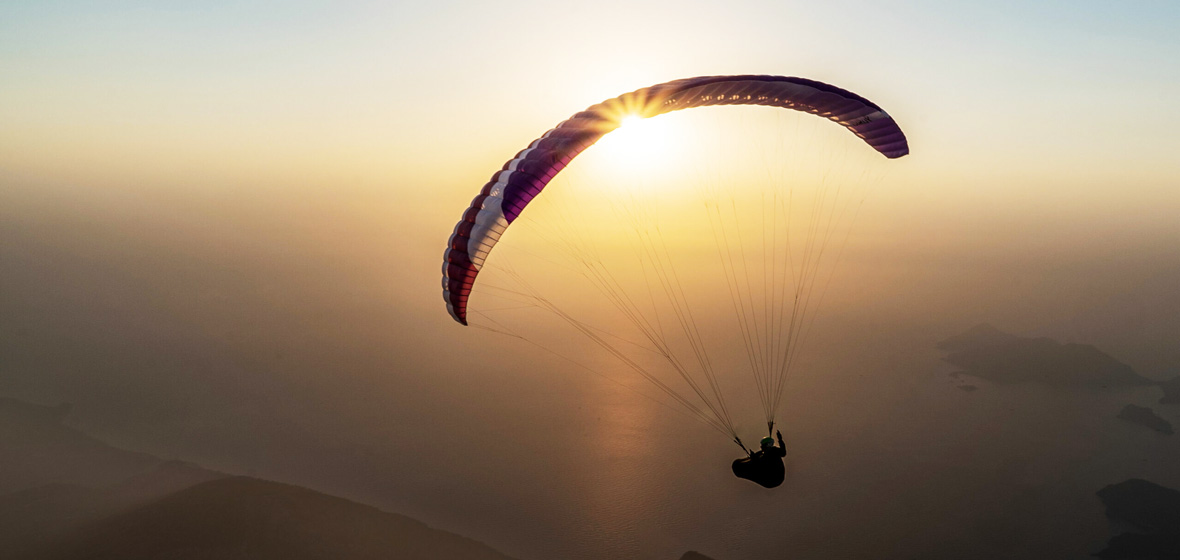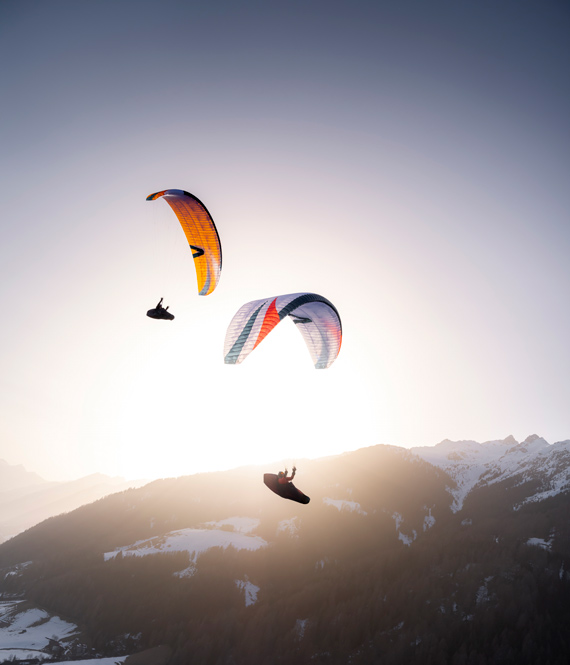HOW TO CHOOSE YOUR PARAGLIDER : SELECTION CRITERIA


Choosing a paraglider can be a complicated process, as the selection criteria are so vast. To help you make your choice, this article gives you a few important points to consider.
Firstly, there's the style of flying. Whether you're aiming for site flying, walk & fly or acrobatics, there will always be paraglider models more or less well suited to every type of paragliding.
Secondly, your level of paragliding is also an important factor. It's precisely your level and your expectations that will guide you towards the most suitable category of paraglider. Finally, your weight is important, as it will be taken into account in addition to the weight of the equipment you're interested in, giving you your TWA, “total flying weight”.
CHOOSING THE RIGHT PARAGLIDER FOR YOU
If you're new to paragliding, it's a good idea to consider the certification of your future wing. There are a number of different approvals available to classify paragliders.
-
EN A paraglider wings: These wings are generally designed for beginner pilots.
-
EN B paragliders: Slightly more powerful than EN A paragliders, these paragliders are aimed at experienced pilots who want to improve performance while maintaining good passive safety.
- Élément de liste
CHOOSING THE RIGHT PARAGLIDER FOR YOUR TYPE OF FLIGHT
As you probably know, there are several paragliding disciplines. Here is a short, non-exhaustive list of the main disciplines and their associated wing types :
-
Site flying : there's really no such thing as a “site” wing , because anyone with any type of glider can take off, fly and land at their preferred flying site.
-
Hike and Fly or Rando Flying : For this type of flying, the choice of glider will vary widely, as pilots may have several objectives in mind. Whether it's for pure rando flying, or a hike followed by a distance flight, you'll find all types of wings (A,B,C,D) available in light or ultra-light versions to suit each objective.
. -
Long-distance flying : Nowadays, it's perfectly possible to make long-distance flights even with beginner EN A wings . However, more experienced paragliders tend to prefer more technical wings that allow longer flights. These wings are more powerful and fly faster. This enables the pilot to fly longer, faster routes. Thinner and easily recognizable by their elongation, paraglider wings designed for long-distance flights will also require active piloting.
-
Acrobatic : For this practice, pilots should opt for small surface wings made to favor a high load factor to make the wing dynamic. These wings are generally only tested under load, and require an advanced level of piloting. Thrills guaranteed!
-
Soaring : Soaring can be done with any type of wing ! However, in areas where the wind can be very strong, mini-paraglider are much better suited to maintaining good airspeed.

CHOOSING YOUR PARAGLIDER ACCORDING TO ITS TWA
As mentioned earlier in this article, the TWA (total weight in flight) is defined by the sum of all the equipment plus the pilot's weight. To get a good estimate of TWA, we generally add the weight of the wing, harness and reserve parachute to that of the pilot. To this total, we add 2 or 3 kg of clothing, shoes and water bottle that can be carried. This gives you a good estimate of your total weight.
Once you've estimated your total weight, you'll be able to identify the appropriate wing size. We can define 3 flight ranges on a wing :
-
Flying at the bottom of the range : This protects your wing, as it is subjected to less stress. Take-off and landing speeds are lower. As a result, you'll generally need to run less, which makes phases close to the ground more comfortable. In flight, you'll have a lower maximum speed, the brake controls will feel a little sluggish and the wing will be less responsive to turns. However, your sink rate will be lower, which will be an advantage in thermals.
-
Flying in the middle of the range : Generally speaking, this is the setting most recommended by the manufacturers, to obtain the best ratio of flight comfort to wing performance. If you have the possibility, fly in the middle / middle-high range.
-
Flying at the top of the fork : Flying at the top of the fork gives the wing better penetration and speed. This is particularly noticeable upwind. The wing is less sensitive to collapses, but when they do occur, they can be more pronounced. Take-off and landing phases are carried out at greater speed. Finally, one of the advantages of flying at the top of the range is that the feel at the controls is generally more pleasant and precise. The wing gains in responsiveness.
CHECK OUR COMPLETE GUIDE TO PARAGLIDING WINGS :
Paragliding gliders: choosing the right flight equipment
Paragliding : discover all types of wings and their uses
Which paraglider is right for you ?
Paraglider comparison: finding the best equipment
Which EN A paraglider to choose ?
Which EN B paraglider to choose ?
How much does a paraglider cost ? Criteria influencing price







